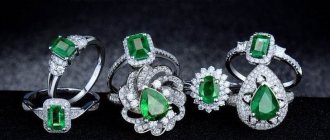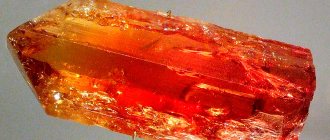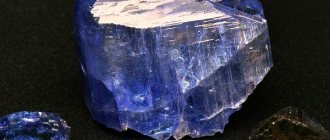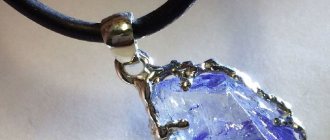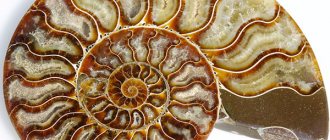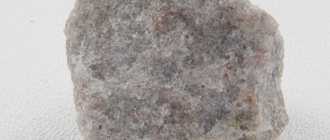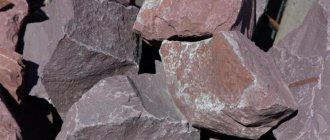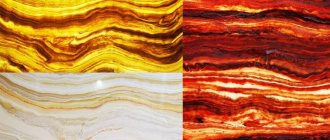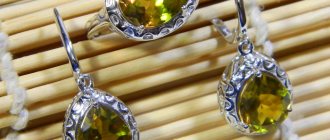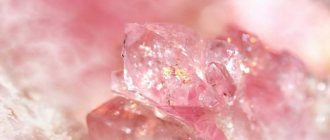History's mistakes and cuckoo zircon
It is assumed that the names zircon and zirconium come from the Persian (distorted) words “tsar” - gold and “hun” - color. That is, the stone is the color of gold.
There is a version that the name of the gem comes from the Arabic “zargun” - cinnabar.
In the East, the shining stone was called the mother of the diamond or its younger brother.
For a long time (until the 18th century), Ceylon gems were brought (and bought) in Europe like diamonds. In general, the gem was mistakenly attributed to the royal family of diamonds. It was easy to make a mistake - the semi-precious stone has a shine comparable to diamond. And even fancy diamonds cannot compare with the color “assortment” of the gem. So, before the advent of instrumental methods for analyzing stones, zircon, like a cuckoo bird, was “thrown” into the nest of diamonds by human opinion.
Russian chemists already at the beginning of the 19th century called zirconium “zircon” or “zircon”.
Cost per gram
The Commonwealth of Australia and the Republic of South Africa have long been the main suppliers of zirconium to the world market. The demand for metal is constantly increasing. And the amount of supplied material remains approximately at the same level. Therefore, its cost is constantly increasing.
At the moment, the price of a gram of cinnabar is about 100-200 rubles.
Zirconium has been known to human society for a century, but it still has not revealed all its secrets to people. It is unclear why the chemical element got its name, or what the full effect of the metal on a living organism is. Probably not all sulfurs are known in which this amazing silver-colored metal can be used.
Physics and chemistry of gems
Characteristics of the mineral:
- has a resinous, glassy to diamond luster, which gives a high refractive index;
- can be transparent, translucent, opaque;
- dash color is white;
- average hardness 7.5 on the Mohs scale.
Zircons necessarily contain rare earth and radioactive elements, as well as copper, titanium, iron, zinc, and calcium.
| Color | brown in various shades, sometimes white, colorless, rarely red, green, yellow, black |
| Stroke color | white |
| Chemical formula | Zr [SiO4] |
| Shine | bold, diamond |
| Transparency | transparent, translucent |
| Cleavage | imperfect |
| Kink | conchoidal, uneven |
| Hardness | 7-8 |
| Specific gravity | 3,9—4,7 |
| Selection form | in the form of well-cut pointed crystals of long-prismatic and bipyramidal habit. The main simple forms are (110), (100), (112), (101), (211) and (331). Zircon twins are observed along (101), rarely along (111) and (211) |
| Classes on taxonomy of the USSR | Silicates |
| singonia | tetragonal |
| Additionally | yellow transparent zircon - hyacinth is transparent. P. tr. doesn't melt |
The color range of gems is quite wide. They come in various shades of brown (from yellow-brown to reddish-brown), red, green, gray or pale gray, pink. There are black and colorless crystals of the mineral.
Curious: if you are in London, go to the Natural History Museum. There is a magnificent collection of zircons collected by Sir A. Church.
Physical and chemical properties
Zircon is a compound of zirconium, the metal named after it. The gem formula is ZrSiO4. It sparkles brightly in the sunlight, although it is inferior to diamond in the play of light. The stone is fragile and easily damaged by harder crystals.
The color depends on which metals replace some of the zirconium atoms in the crystal molecules.
This is a semi-precious gem with a rich coloring. There are minerals of all colors of the rainbow - red, yellow, green, blue, violet, cyan, colorless, brown, black.
Jewelers most like transparent minerals with a reddish color; they are called hyacinths. If such a pebble is heated, it will turn bright blue. There are also techniques that allow you to obtain yellow or colorless stones. Sometimes you come across very bright specimens with uranium in the crystal lattice, but they do not go on sale due to dangerous radioactivity.
Color and name
Some zircons are honored to have a personal name, and it is given according to the color of the natural mineral.
The varieties of the mineral amaze not only with their diamond shine, but also with the variety of their palette.
- For a long time, the “little brothers of diamond” were imported to Europe from one place - Ceylon (now Sri Lanka). The color scheme of the “brothers” ranges from brown-orange, through yellow to olive-green. Colorless crystals were also found (or maybe ancient craftsmen annealed the stones). Such colorless gems were called “matura diamonds.”
- Jargon, or Siamese zircon is a straw yellow, golden yellow or smoky gem.
- Hyacinth often resembles the flower of the same name in color. They are red-brown, red or brown, orange.
Earrings with hyacinth - Starlite is a bright blue stone. The appearance of natural gems is extremely rare. Almost all starlites received color by annealing brown zircons.
- Malacon. Brown-black, black gem. It has weak radioactivity.
- Green zircon does not have its own name. However, it always has radioactivity. And if pale green stones “give off” little light, then bright green ones can be dangerous if worn constantly.
Interesting: starlite got its name from the chief gemologist.
But Pliny, the author of Natural History, was not impressed by hyacinth: “Hyacinth is sharply different from... amethyst, although they are similar in color. The greatest difference is that the bright violet color, so brilliant in amethyst, is diluted in hyacinth.”
Zircon variety
Looking at a photo of a gem, you can see how varied in color specimens can be found. Experts divided all the stones into groups and gave each a name depending on the predominant shade:
- Hyacinth is a mineral in which orange, red, and brown colors predominate.
- Jargon - translated from Persian this name sounds like “golden”. This variety has a yellow, slightly golden or warm straw hue.
- Matarsky is a colorless crystal that gets its name from its place of origin. The deposit is located in the depths of the island of Matara, located on the southern coast of Sri Lanka. The transparent stone is one of the most expensive on the jewelry market.
- Starlite - this variety is obtained by firing at high temperatures. This allows you to change the original color, and the stone becomes bluish. Many gems take on a delicate purple tone.
- Malakon is a rich brown or even black mineral. It contains a small dose of radiation. Many people are mistaken in thinking that such a stone is harmful to humans; experts have proven that the radiation that it contains is completely safe.
- Matur diamond is a white stone that is almost impossible to find in nature. It gets this color after heating colored stones.
You can also find a green stone. It acquires this shade thanks to the uranium it contains. The tint palette includes tints of light green, rich emerald, and turquoise. The spring green color of the stone also attracts many connoisseurs of beauty. Uranium makes the gem radioactive, but this element contains in very small quantities and is not harmful to humans.
The cost of a cut gem is determined by many indicators. The residual amount is affected not only by the weight of the stone, but also by the color of its edges. It is worth noting that all varieties of the mineral look great in finished jewelry.
Where is the “mother of diamonds” used?
Don’t think that our gem is a slacker who can only show off in jewelry. Its meaning for a person is priceless.
The scope of application of the mineral includes the extraction of zirconium and hafnium from it.
Zirconium replaces expensive platinum in instrument making and in the production of spark plugs for internal combustion engines.
A rare property of zirconium is its exceptional corrosion resistance (well, it doesn’t want to rust). Products made of zirconium and its alloys are not destroyed in cold solutions of acids, alkalis, or ammonia. Sea water does not corrode this metal.
The properties of zircon stone allow it to be used in various industries.
The mineral is used to produce zirconium dioxide. It is used to produce particularly durable paints and is added to heat- and acid-resistant laboratory glassware.
The Ministry of Health has authorized the use of zirconium alloys in the manufacture of endoprostheses, implants, and dentistry.
Nowadays, real zircons are almost impossible to find in jewelry. Cubic zirconia is now usually sold under the brand name “zirconium” instead of natural gem crystals. But in ancient jewelry, natural gems are found quite often.
Ring with cubic zirconia stone
Metal properties
Synthetically produced zirconium is a silvery-white metal. The appearance of cinnabar is similar to steel. The metal has unique properties that no other natural formation has.
Physical
Cinnabar has the following physical properties:
- thermal conductivity - 23.86 W/(m x K);
- boiling point approximately 4350 °C;
- elastic modulus – 95–97 GPa;
- rigidity – about 600–1700 MPa;
- ability to withstand heating up to 2600 ˚C without deformation;
- density 6.5-10 g per cm3.
Silver-colored metal also has plasticity; it can melt in a vacuum and in inert gases.
Chemical
The most important chemical property of zirconium is its high resistance to corrosion even when exposed to acids and alkalis. But this ability decreases when exposed to high temperatures. Silver-colored metal can also form alloys with other chemical elements.
Biological
Cinnabar also has biological properties. It has a huge positive effect on the human body. The good functioning of some organs depends on zirconium, because it is a bioelement and is included in the structure of their cells. These data were obtained by domestic physiologists quite recently during additional studies of the chemical element. All the positive qualities of zirconium are being studied gradually, and new facts about the silver-colored metal become known almost every year.
Many leading clinics specializing in maxillofacial surgery and traumatology use the latest method. It involves the use of special fixators for multiple bone fractures. These devices hold the fragments together and prevent movement of parts of the bone. This promotes faster tissue fusion, hence faster healing of fractures. These retainers are made from zirconium. Also, alloys of titanium, stainless steel, and cinnabar are used to create various screws, staples, plates, and fasteners, which are used in surgery and even during operations on the brain and spinal cord.
Implants made from cinnabar alloys have many advantages over other materials:
- the ability not to rust even in an aggressive, acidic environment;
- high biological compatibility with any tissue of the human body;
- absence of allergic reactions when cells interact with zirconium objects;
- excellent strength of the clamps, despite the fact that their design is often simple.
Due to their unique structure, alloys have a low density, so products made from them have a lightweight weight. This quality is also valuable in the manufacture of retainers. To all of the above, we can add that the plasticity of silver-colored metal allows you to create devices that fully correspond to the contour of the damaged bone.
Cinnabar does not irritate the surrounding soft and inert tissues, but on the contrary has a beneficial effect on them. Doctors have found that zirconium earrings (put in immediately after the mini-surgery) promote rapid healing of wounds on the earlobes after piercing. The process goes much faster than when wearing gold items.
If you constantly wear jewelry made of silver metal, you will soon notice an improvement in your general physical condition. And weather-dependent people stop reacting sharply to temperature changes and magnetic storms. Doctors have already experimentally established that zirconium products have the following medicinal properties:
- bracelets relieve irritation due to skin diseases and stabilize blood pressure;
- belts help in the treatment of diseases of the musculoskeletal system;
- plates that are applied to joints relieve pain in arthrosis and arthritis.
Even when making dental prosthetics, experienced dentists recommend choosing materials made from cinnabar.
But do not forget that zirconium products are not a panacea for all diseases. You must follow all your doctor’s orders and take your medications. And cinnabar will enhance the effect of traditional medicine.
Let's be clear
For many, zircon and zirconium are the same thing. And if we talk about cubic stabilized zirconium, then the majority will be at a dead end.
But in fact, everything is simple.
Zirconium is a metal. In the periodic table of Mendeleev (ugh, about chemistry, most will say...) a metal with atomic number 40. Write Zr to a chemist, and he will automatically read “zirconium”.
Zircon is the name of a mineral whose crystals are used in jewelry. Chemical formula of ZrSiO4. Take a closer look and you will see the designation zirconium in the formula.
Cubic stabilized zirconium, or simply cubic zirconia. A magical invention of magicians and sorcerers from the Lebedev Physical Institute. "The Poor Man's Diamond", a stone with excellent jewelry qualities. In the jewelry industry, colored artificial zircon is used as a substitute for expensive precious stones.
Important: abroad it is called zirconite.
If you see “zirctone” in the window, don’t consider it the seller’s illiteracy.
Zirkton is a brand name for synthetic corundum that is bluish-green in color. Sold as imitation sapphires.
And there is also citrine (you can read about it here), but that’s a completely different story.
Place of Birth
Zircon is most often an additional mineral that is included in the rock in very small quantities. It does not affect the general classification of the main rock and acts as an accessory mineral. Zircon is of igneous origin and is found in granites, pegmatites, and syenites.
In Russia, this mineral is found in emerald mines in the Urals and among the Yakut diamond deposits. Pure gem-quality stones are also mined in Burma, Thailand, Norway, Vietnam, Sri Lanka and the island of Madagascar.
Sorcerers from FIAN
When looking at cubic zirconia, one always remembers the Strugatsky brothers’ masterpiece “Monday Begins on Saturday.” In this book, real magicians and sorcerers worked at NIICHAVO.
The same sorcerer scientists created a “cubic stone”, cubic zirconia, at the Lebedev Physical Institute. Simple formula - zirconium dioxide, minimum price. And the result is amazing.
The main “work” of cubic zirconia is its use in jewelry.
It was called the "poor man's diamond." Low price, the possibility of adding substances that give color to cubic zirconia, diamond shine - these are the advantages of synthetic stone.
There are seven types of "poor man's diamond" color:
- when adding cerium, the resulting pebble will be red, yellow, or orange;
- add erbium - cubic zirconia will turn pink;
- can be sold for greenish sapphire if chromium is added to cubic zirconia;
- combine with a small amount of titanium - we get a stone of a golden-brown (cognac) hue;
- If the goal is to get an imitation of kunzite, sapphire, amethyst - add neodymium and get purple cubic zirconia.
Every woman wants to wear sapphires and diamonds. It's not always her fault that she doesn't have such jewelry.
But every woman can buy earrings or a ring with cubic zirconia. And feel like a goddess!
Let's refine the gem
Just heating (annealing) the stone, and what an effect! Brownish Cambodian zircons take on a stunning blue color. Connoisseurs compare it with expensive Paraiba tourmalines.
And if you burn the gem a second time, but in an oxygen atmosphere, the color will change to yellow. But yellow is different from yellow. Here you get just a piece of sun in the palm of your hand.
The sheaves of rays from the facets of the gem blind the eyes, and the gem shimmers in the sun incredibly beautifully!
Interesting: the most beautiful blue zircons are obtained by heating Cambodian gems.
Properties of zirconium (table): temperature, density, pressure, etc.:
Detailed information on the website ChemicalStudy.ru
| 100 | General information | |
| 101 | Name | Zirconium |
| 102 | Former name | |
| 103 | Latin name | Zirconium |
| 104 | English name | Zirconium |
| 105 | Symbol | Zr |
| 106 | Atomic number (number in table) | 40 |
| 107 | Type | Metal |
| 108 | Group | Transition metal |
| 109 | Open | Martin Heinrich Klaproth, Germany, 1789 |
| 110 | Opening year | 1789 |
| 111 | Appearance, etc. | Ductile, shiny silver-gray metal |
| 112 | Origin | Natural material |
| 113 | Modifications | |
| 114 | Allotropic modifications | 3 allotropic modifications: – α-zirconium with a hexagonal close-packed crystal lattice, – β-zirconium with a cubic body-centered crystal lattice, – ω-zirconium with a hexagonal crystal lattice |
| 115 | Temperature and other conditions for the transition of allotropic modifications into each other | |
| 116 | Bose-Einstein condensate | |
| 117 | 2D materials | |
| 118 | Content in the atmosphere and air (by mass) | 0 % |
| 119 | Content in the earth's crust (by mass) | 0,013 % |
| 120 | Content in seas and oceans (by mass) | 2,6·10-9 % |
| 121 | Content in the Universe and space (by mass) | 5,0·10-6 % |
| 122 | Abundance in the Sun (by mass) | 4,0·10-6 % |
| 123 | Content in meteorites (by mass) | 0,00066 % |
| 124 | Content in the human body (by weight) | 5,0·10-6 % |
| 200 | Properties of the atom | |
| 201 | Atomic mass (molar mass) | 91.224(2) a. e.m. (g/mol) |
| 202 | Electronic configuration | 1s2 2s2 2p6 3s2 3p6 3d10 4s2 4p6 4d2 5s2 |
| 203 | Electronic shell | K2 L8 M18 N10 O2 P0 Q0 R0 |
| 204 | Atomic radius (calculated) | 206 pm |
| 205 | Empirical atomic radius* | 155 pm |
| 206 | Covalent radius* | 148 pm |
| 207 | Ion radius (crystalline) | Zr4+ 73 (4) pm, 86 (6) pm, 98 (8) pm (in parentheses the coordination number is indicated - a characteristic that determines the number of nearest particles (ions or atoms) in a molecule or crystal) |
| 208 | Van der Waals radius | |
| 209 | Electrons, Protons, Neutrons | 40 electrons, 40 protons, 51 neutrons |
| 210 | Family (block) | d-family element |
| 211 | Period in the periodic table | 5 |
| 212 | Group on the periodic table | 4th group (according to the old classification - a secondary subgroup of the 4th group) |
| 213 | Emission spectrum | |
| 300 | Chemical properties | |
| 301 | Oxidation states | -2, +1, +2, +3, +4 |
| 302 | Valence | II, III, IV |
| 303 | Electronegativity | 1.33 (Pauling scale) |
| 304 | Ionization energy (first electron) | 640.1 kJ/mol (6.634126(5) eV) |
| 305 | Electrode potential | Zr4+ + 4e– → Zr, Eo = -1.539 V |
| 306 | Electron affinity energy of an atom | 41.1 kJ/mol |
| 400 | Physical properties | |
| 401 | Density* | 6.52 g/cm3 (at 20 °C and other standard conditions , state of matter – solid), 5.8 g/cm3 (at melting point 1855 °C and other standard conditions , state of matter – liquid) |
| 402 | Melting temperature* | 1855 °C (2128 K, 3371 °F) |
| 403 | Boiling temperature* | 4377 °C (4650 K, 7911 °F) |
| 404 | Sublimation temperature | |
| 405 | Decomposition temperature | |
| 406 | Self-ignition temperature of a gas-air mixture | |
| 407 | Specific heat of fusion (enthalpy of fusion ΔHpl)* | 14 kJ/mol |
| 408 | Specific heat of evaporation (enthalpy of boiling ΔHboiling)* | 591 kJ/mol |
| 409 | Specific heat capacity at constant pressure | |
| 410 | Molar heat capacity* | 25.36 J/(K mol) |
| 411 | Molar volume | 14.1 cm³/mol |
| 412 | Thermal conductivity | 22.6 W/(mK) (at standard conditions ), 22.7 W/(mK) (at 300 K) |
| 500 | Crystal cell | |
| 511 | Crystal grid #1 | α-zirconium |
| 512 | Lattice structure | Hexagonal close-packed |
| 513 | Lattice parameters | a = 3.231 Å, c = 5.148 Å |
| 514 | c/a ratio | 1,593 |
| 515 | Debye temperature | 291 K |
| 516 | Name of space symmetry group | P63/mmc |
| 517 | Symmetry space group number | 194 |
| 521 | Crystal grid #2 | β-zirconium |
| 522 | Lattice structure | Cubic body-centered |
| 523 | Lattice parameters | a = 3.61 Å |
| 524 | c/a ratio | |
| 525 | Debye temperature | |
| 526 | Name of space symmetry group | Im_ 3m |
| 527 | Symmetry space group number | 229 |
| 900 | additional information | |
| 901 | CAS number | 7440-67-7 |
Note:
205* The empirical radius of the zirconium atom according to [1] and [3] is 160 pm.
206* The covalent radius of zirconium according to [1] and [3] is 175±7 pm and 145 pm, respectively.
401* The density of zirconium according to [3] and [4] is 6.506 g/cm3 (at 0 °C and other standard conditions , the state of matter is a solid) and 6.45 g/cm3 (at 20 °C and other standard conditions , state of matter – solid) respectively.
402* The melting point of zirconium according to [3] is 1851.85 °C (2125 K, 3365.33 °F).
403* The boiling point of zirconium according to [4] is 4320 °C (4593.15 K, 7808 °F).
407* The specific heat of fusion (enthalpy of fusion ΔHmelt) of zirconium according to [3] and [4] is 19.2 kJ/mol and 14.6 kJ/mol, respectively.
408* The specific heat of evaporation (boiling enthalpy ΔHboiling) of zirconium according to [3] and [4] is 567 kJ/mol and 557.7 kJ/mol, respectively.
410* The molar heat capacity of zirconium according to [3] is 25.3 J/(K mol).
Gem magic
Zircon is a stone of truth and justice. The magical properties of zircon will bring deceivers and scammers to the surface. A talisman or gem jewelry will help judges, criminologists, and scientists.
The energy of the gem is masculine. A ring with a stone of a calm color and a tie pin will well complement the image of a successful man.
The zircon stone will create all sorts of obstacles for liars and scammers, and can cause great harm in scams. In any case, initiates have been confident of this for a long time.
Moms and dads! Give your daughters earrings with zircon in yellow shades. The girl will be happy with the decoration, and the magic of the mineral will increase perseverance and diligence in her studies. That's what the esotericists say.
From ancient times to the present day in India, girls wear zircon stones. They are sure that the amulet will protect against temptations and (since it did not protect) from unwanted pregnancy.
Esotericists believe that excessive fatness is a disorder in the physical and spiritual parts of a person. The energy of the mineral brings both of these parts into balance. Therefore, overweight people are advised to wear a pendant or pendant made of gems.
Help with treatment
Lithotherapists are confident that the healing properties of the mineral help heal nervous disorders and cope with mental problems.
It has long been believed that the stone alleviates the condition of patients with coronary heart disease.
Anesthesia, intoxication during poisoning - zircons can cope with this (as esotericists say). It is useful to wear earrings with the “little brother of the diamond” for vision problems.
Stones of different colors “work on different diseases”:
- blue - speed up metabolism, help cope with constipation, reduce appetite, promote weight loss;
- dark red and black will help cope with colds;
- yellow and yellow-red help the liver function and drive away nightmares.
Of all the zircons, lithotherapists consider hyacinth to be the most powerful.
Astrology
The patron planets of the mineral are the Sun and Saturn.
For Capricorns, zircon is a lucky find. Representatives of this zodiac sign can collect a whole collection of gems of different colors. Each pebble will give Capricorn its help.
The mineral has a light disposition:
- Sagittarius;
- Aquarius;
- Scales;
- Aries;
- Taurus.
The gem will easily make friends with these signs. You just need to choose the right color:
- Aquarians can choose colorless, yellow, blue, golden colors.
- Capricorn will receive the best help from yellow and blue stones. But gems of a different color will go very well with it.
- Aries - the fiery lamb - will like jewelry with red and golden gems.
Cancers and Pisces should either not wear zircons, or wear them infrequently - the stone is not suitable for these zodiac signs.
Let's preserve zircon in all its glory
Caring for a gem is easy.
Zircon is a fragile stone. Do not apply mechanical force to it, drop it, or scratch it.
If you buy jewelry with the “mother of diamonds”, make sure that the stones are in special, high frames.
The gem does not tolerate household chemicals. So before washing dishes or washing, the ring with the zircon insert will have to be removed.
It is better to wash contaminated jewelry in warm water with baby (neutral) soap. Rinse under running water, dry carefully with a cloth.
Store jewelry with zircons separately from other jewelry. In bags made of soft, thick fabric, in cases, boxes or caskets, lined with soft (velvet, plush) material on the inside.
Counterfeits, imitations, synthetics
A natural mineral suitable for jewelry is becoming increasingly rare. To be honest, you can hardly find it in jewelry stores. But there are a lot of artificial stones.
Let's try to find the difference between a natural gem and zircon:
- A magnifying glass will help you. Let's take a closer look at the stone. In the present there will always be inclusions, voids and other traces of natural origin. Synthetic stone does not have such traces.
- Sometimes a natural gem is weakly radioactive. There is a device for determining radioactivity - measure the background from the stone.
- Zircon looks and shimmers like a real diamond. But only where there are inclusions or a resinous tint.
Red gems with a purple tint can be passed off as high-quality amethyst. Green zircon is sometimes passed off as demantoid, chrysolite, even emerald. Blue can be sold as sapphire. Although the properties of these stones have strong differences.
